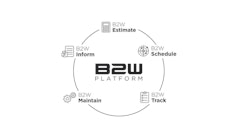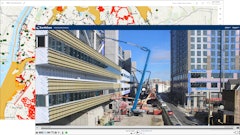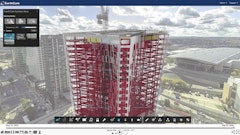
Major vocational truck OEMs are targeting reduced downtime through the utilization of onboard telematics systems. These systems diagnose problems and allow fleet managers to make educated decisions, such as whether the truck needs to be routed to a service shop for immediate repairs or can complete its assigned task and be serviced when the timing is more convenient.
Some companies are going further by tying telematics into factory-backed support, which allows the OEMs and dealer to interpret fault codes and develop actions plans that can slash unplanned downtime.
The objective is to schedule maintenance when it is necessary to prevent failures while minimizing unnecessary downtime due to nuisance issues. Dave Hillman, vice president and general manager of vocational trucks, Navistar, claims most drivers can be divided into one of two camps. “When a light comes on the instrument panel it is a fault code of some kind. You either have drivers in Camp A that immediately pull over to the side of the road and say ‘there is a light on, call a wrecker.’ The [Camp B] group has a roll of electrical tape. They pull off an inch of electrical tape and they place it over the light so they don’t have to look at it. They pretend nothing happened and they keep going. Both of those behaviors are bad ones if you are the owner of the asset.”
Telematics systems, such as Navistar’s OnCommand Connection provide a better solution. Not all indicator lights are created equal. “Some of them are benign. Some of them are urgent. OnCommand Connection gives the owner, dispatcher or someone in a more centralized location the ability to look at segmented data on a computer screen or smartphone,” says Hillman. “OnCommand Connection puts into plain English what to do with that asset.”
The fault code is coupled with a health report. “It is a way to triage patients before they even come to the front door of the emergency room,” says Hillman. For instance, Unit 17 may need an air filter swapped but is fine to continue with its delivery, while Unit 19 might need to come in right away.
“We have had fleets that have already saved over 30% in downtime just by having better knowledge about what the vehicle is telling them,” notes Hillman.
Mack Trucks continued its journey to cut downtime by combining telematics data with live support personnel in 2014. “In December 2014, we opened our Uptime Center, which demonstrates our commitment to keeping customers on the road, driving the success of their businesses,” says John Walsh, vice president of marketing, Mack Trucks. “The Uptime Center is open 24/7 and is staffed by customer support specialists who work with the customers and dealers to resolve any issues as quickly as possible.
“We have evolved how we do business to maximize customer uptime,” he continues. “Our GuardDog telematics-based solution proactively monitors the truck, keeping an eye out for potential issues before they become real ones. If a potential issue is detected, skilled uptime technicians in Greensboro, NC, work with the customer to manage through the situation, including scheduling a repair time at a dealer, ensuring any required parts are there before the truck arrives and also providing relevant repair instructions, all while that truck is still on the road.”
A Coordinated Effort
Mack Trucks’ telematics system works in conjunction with Mack Certified Uptime Centers to reduce the time the truck spends sitting in the shop. “GuardDog Connect monitors about 50 fault codes on the engine and powertrain so if there is an issue, we know about it before the driver or the owner knows about it,” says Curtis Dorwart, vocational product manager, Mack Trucks. “We can then manage the situation with the dealer, tell them what is wrong with it and find out if he has the parts. We will call the customer and schedule the truck in there so that when it does come in, they can jump on it right away and get it in and out of there as quickly as possible.
“We know when the truck gets there and when it leaves because it is geofenced,” says Dorwart. “There is an invisible fence around the dealership. If we see it sitting there, we are making phone calls and asking questions. We will send people out there to make it happen. That is all part of our uptime strategy. It is not just an employee answering a phone.” It is a total process of aftermarket support powered by GuardDog Connect.
“Through our Mack Certified Uptime Centers, we are improving the throughput of the dealership,” says Walsh. “We are establishing dedicated uptime bays for repairs taking less than four hours. The end result is quicker turnaround for all of our customers, particularly those with these quick fixes.”
Daimler Trucks uses Virtual Technician to eliminate any surprises. “Virtual Technician’s core functionality is valuable for fleets of all applications,” says Matthew Pfaffenbach, director, telematics, Daimler Trucks North America. “Its ability to categorize engine and aftertreatment faults can help avoid unnecessary visits to a shop, ensuring the truck can continue work at the jobsite, or deliveries can be made on time. If it is a serious issue, the fleet is in the know right away and can use that information to make a quick decision as to where to take the truck and get it repaired as fast as possible and back to work.”
Virtual Technician records engine and aftertreatment system fault code events. “Within minutes, this data is transmitted through cellular communications notifying customers via e-mail,” says Pfaffenbach. “Complete fault event details can also be viewed via the Detroit Connect portal, which will be available to customers Fall 2016.”
Critical fault codes are further analyzed by Detroit Customer Support Center (CSC) experts. “Virtual Technician classifies fault codes into three categories: service info, service soon and service now,” says Pfaffenbach. “During select service now events, the engine data from 60 seconds before, during and 15 seconds following the fault event is sent directly to the Detroit CSC for analysis. A CSC expert then sends a follow-up notification to the customer within 30 minutes. The notification outlines the cause of the fault event, the recommended parts to fix the problem and the nearest service locations with those parts in stock.
“Virtual Technician can help minimize downtime by helping customers make informed business decisions so that they only service their vehicles when needed,” he adds. This happens in one of two ways:
- Virtual Technician can inform the fleet if the fault event is something that requires attention but can wait until the end of the work day or after the delivery has been made, and
- Virtual Technician can inform the fleet if the fault is “driver actionable” — or can be resolved by the driver — allowing the fleet to avoid taking the truck in for repair.
“Twenty percent of Virtual Technician fault codes are driver actionable,” notes Pfaffenbach. “If a truck experiences an issue that requires it be brought into a shop immediately, Virtual Technician, with the help from the Detroit CSC, can help reduce diagnostic time and help get the truck repaired right the first time.”
Virtual Technician comes standard with two years of service on any Freightliner or Western Star truck equipped with a Detroit engine. “Currently, Virtual Technician communicates to the fleet using email so no specialized website or app is required,” says Pfaffenbach. “However, in late 2016, a new portal will be available to Detroit Connect customers. This new interface will allow users to dive deeper into specific fault events communicated through Virtual Technician.”
An All-makes Ssolution
Navistar is also targeting uptime via its OnCommand Connection telematics system. “It turns unscheduled downtime into a scheduled activity,” says Dave Hillman, vice president and general manager for vocational trucks.
Based on its prior telematics experience, Navistar has taken a unique approach. “We decided we were going to make OnCommand Connection an open technology platform. We are not telling customers that if you work with International, you have to do business with our partner,” says Hillman.
There are currently 16 telematics data suppliers signed up with Navistar, with more expected in the near future. “We allow customers the freedom of choice for what works best with their operations. Then we enable it through OnCommand Connection,” Hillman explains.
Navistar recognizes that a mixed fleet is very typical as fleets merge and consolidate or acquire assets from other sources. A customer-centric approach must address this reality.
Being an open technology platform allows OnCommand Connection to service these mixed fleets. “OnCommand Connection actually works on all makes of vehicles,” says Hillman.
OnCommand Connect presents the same information regardless of brand, including the location of the closest service shops for each brand. “We have mapped out where all of the competitive dealers are located,” says Hillman. If Unit 19 is Brand X, you may need to take it to a Brand X dealer if it is a warrantable repair. ”We would rather give the customer that information so they can choose where it is best for them to take the equipment. If it is not in the customer’s warranty, we would certainly prefer that they would go to the International dealer.”
Presenting data in a clear format was a priority. “We have a dashboard that has been very well received by customers,” Hillman states. “It makes it pretty simple. Not only is it graphic in the way information is presented, but it also uses plain English in terms of what is going on. A fault code is very cryptic. I don’t know what 197-84 means. I have to go to some other source to figure that out. OnCommand Connection already has the repository of what the fault code is and then what needs to be done in plain English.”
The data collected transcends the long-haul fleets and can be very beneficial to vocational customers, as well. “Every truck has electronic information on it right now,” says Hillman. “Presenting that in real time to the owner or the fleet manager just allows them to keep those assets operating at their best.”



![[VIDEO] Mack Guard Dog Connect Telematic System Improves Truck Uptime](https://img.forconstructionpros.com/files/base/acbm/fcp/image/2016/02/default.56b36cf6d35e9.png?auto=format%2Ccompress&fit=crop&h=75&q=70&w=75)

























